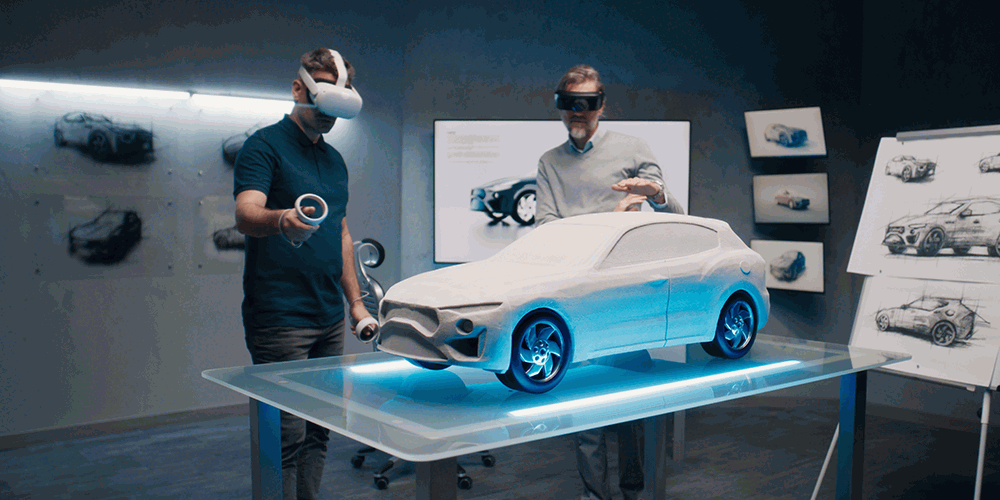Businesses from different sectors will step up their investments in Virtual Reality (VR) development during 2025 because they see its substantial impact bounds. The Meta’s Reality Labs achieved a 40% annual growth in sales between 2023 and 2024 due to rising corporate use of virtual reality technologies. The maturation of VR technology enables organizations to utilize this technology for engaging customers while improving employee training and enhancing product design alongside promoting collaboration and marketing initiatives. The investments businesses make lead them to outpace their competitors while becoming digital transformation leaders.
Enhancing Customer Engagement
The primary motivation behind business investment in VR is its capability to produce next-level immersive engagements with customers. Today VR incorporates new strategies that provide deeply engaging customer experiences as traditional methods continue to lose popularity
Gucci together with other luxury fashion brands sustains innovation leadership through the integration of VR in their marketing plan which leads to virtual showroom platforms that customers can experience through their home devices. The immersive experience creation expertise of specific businesses including TwinReality allows companies to achieve deep customer involvement. Online shopping through virtual platforms delivers true representation of products which enables customers to touch and feel before taking steps businesses cannot reach at the standard electronic marketplace.
The tourism sector utilizes VR technology to grant users virtual access to explore travel destinations so they can choose their destinations before making reservations. Travel agencies benefit from virtual previews that deliver better lead conversion rates to their clients. The implementation of VR tours by hotels and resorts generates better booking rates through their facility expos.
Revolutionizing Employee Training
Since employees rarely respond well to training there has always been a challenge because of training expenses as well as spatial limitations and safety protocols. The technology of VR solves these problems through its ability to deliver authentic simulations which help staff gain practical training inside secure virtual conditions.
The medical staff at UC San Diego enhances minimally invasive surgery outcomes and minimizes medical staff injuries through their adoption of VR headsets. By using this method doctors gain the chance to practice advanced clinical procedures numerous times without endangering actual patients. VR applications have entered aviation through simulated flight operations that replicate genuine air traffic scenarios thereby enabling pilots to develop their operational readiness prior to aircraft takeovers.
The application of VR-based training allows industrial personnel to master safe machine operation procedures which decreases workplace safety incidents and helps eliminate non-compliance issues. A combination of safer operations and reduced training expenses defines the benefits VR brings to organizations which incorporate it for their training programs.
Streamlining Product Design and Development

VR transforms product development by giving engineers and designers capabilities to transform virtual prototypes before manufacturing their physical counterparts. Design speed increases and costs decrease together with design errors reduction through these processes.
BMW together with Ford implement VR technology to design vehicles while their engineers verify different vehicle aspects using digital prototypes without creating physical versions. Virtual reality simulation platforms enable designers to achieve faster design improvements through the assessment of aerodynamic and safety performance and ergonomics testing.
VR-based product development helps both architecture and real estate sectors achieve better results in their workflows. AssemblyVersion Mode enables architects to develop three-dimensional architectural models of constructions which clients can explore virtually before construction takes place. Correct communication with clients becomes possible through this approach which results in accurate planning and enhances customer satisfaction.
Facilitating Remote Collaboration
Businesses take advantage of VR technology to support team collaboration between professionals who work in separate locations because of remote work practices. Remote work tools similar to video conferences function effectively yet insufficiently replicate the comprehensive engagement possible in VR-based collaborative environments.
Accenture together with Microsoft run VR-powered virtual office environments where their employees conduct meetings while conducting brainstorming activities and working collectively on projects through digital shared spaces. Remote employees can use virtual office spaces that duplicate actual workplace meetings to preserve team work excellence across geographic distances.
The educational sector together with training institutes embrace VR collaboration at an increasing rate. Students across the world can communicate with their instructors and classmates through VR-based training centers operated by universities and professional institutions. The educational landscape becomes more available and interactive due to these advancements.
Driving Sales and Marketing Strategies
The adoption of VR technology by businesses enables new ways of presenting products during their commercial processes. The functionality of showing customers virtual replicas of products before buying has proven to be a transformative tactic in the marketplace.
Property evaluation companies use Virtual Reality technology to introduce clients to virtual home inspections. Real estate and commercial property sellers now let interested buyers examine their spaces using virtual reality tours that deliver interactive online experiences. Through this approach customers obtain needed information which leads to accelerated sales activities.
Retail businesses now maintain digital stores for shopping that deliver a virtual storefront experience to their customers. Nike and Adidas among other brands enable customers to use their VR-powered shopping platforms which let them virtually try clothing products before they buy them.
Reducing Costs and Risks

The implementation of VR systems in businesses results in cost reduction through error minimization along with safer operations and lower operational costs.
Industrial organizations employ VR to perform real-time inspections of machines and conduct maintenance procedures. Through VR simulations technicians can identify equipment problems before performing actual maintenance thus avoiding both equipment downtime and latter repair expenses. Companies that work in the oil and gas sector benefit most from this preventive strategy since equipment problems lead to severe economic losses and environmental damage.
Healthcare providers employ VR for phobia and mental illness treatment by using exposure therapy processes. The method permits patients to undergo controlled fear-based virtual reality simulations which partly replace the necessity for costly in-person treatments.
Catering to the Next Generation of Consumers
The growth of Generation Z’s purchasing power drives businesses to adopt VR solutions that match their requirement for immersive touchscreen-friendly activities. VR acts as an excellent medium to attract digital-first customers who belong to younger demographics.
Both Google and Roblox continue developing their platform ecosystems to enable brands to open virtual sales fronts which distribute real products within their three-dimensional interactive virtual worlds. By implementing this approach businesses reach young demographics and develop new online retail standards for future market expansion.
VR becomes a popular tool for entertainment corporations that develop interactive entertainment content for their audiences. Virtual reality technology enables users to experience concerts and live events and play games from the front row without needing physical presence at the event through its implementation by concerts and gaming and live events.
Conclusion
Businesses invested heavily in VR during 2025 because this adaptable tool shows the ability to transform multiple operational areas. Organizations use VR both to advance customer interaction and train personnel better but also implement it for product improvement and maintain collaborative relationships remotely thus demonstrating its critical status.
The business world will embrace an improved and more efficient future because TwinReality and similar companies create customized VR solutions that propel industry transformations. Organizations that start using VR today will obtain current market dominance while preparing themselves for digital market success in the future. The business landscape moves beyond being an emerging trend because Virtual Reality now represents an essential paradigm change in operational methods and customer and employee engagement.
The ongoing development of VR technology enables businesses to create novel possibilities which establish better industry benchmarks while maintaining their lead in digital innovation.


